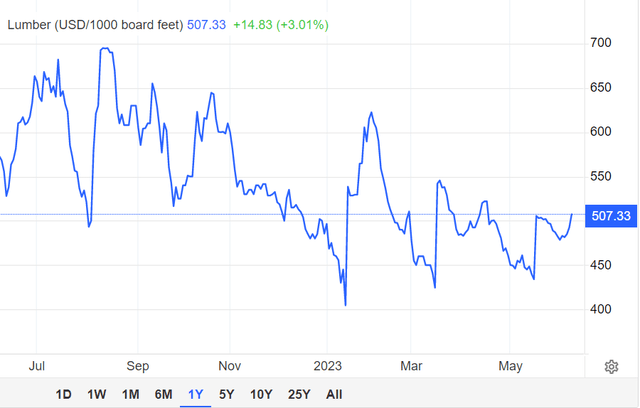Lennar: A Gentle Trough In This Cycle
Summary
- Lennar's price has increased significantly.
- The fundamental outlook has similarly improved.
- I still see opportunity in LEN.B shares.
- Looking for more investing ideas like this one? Get them exclusively at Portfolio Income Solutions. Learn More »
Kirk Fisher
As the broader market anxiously awaits whether it will be a soft or hard landing following the rapid interest rate hikes, it increasingly appears that homebuilding will have a soft landing despite being one of the areas most directly affected by interest rates. Lennar (NYSE:LEN), despite its now higher market pricing, remains opportunistic. In particular, I like the class B shares (NYSE:LEN.B) due to their ~11% discount.
In this article we will detail why I believe it will be a soft landing and that perhaps minimum earnings are already in followed by a quick recovery.
The trough
In 2022, Lennar earned $17.91 normalized earnings or $15.72 in GAAP earnings. That forms a 6.4X multiple on normalized earnings for the trailing year which is nominally cheap, but fairly normal for a cyclical peak. The market expects LEN's earnings to drop substantially to about $10.04 in 2023.
S&P Global Market Intelligence
Consensus then expects earnings to mildly recover in 2024-2026. So, today's market price represents an 11.35X multiple on expected trough earnings.
I agree with the 2023 number but believe LEN earnings will recover faster than expected for the following reasons
- Lumber pricing
- Long-term home shortage
- Dearth of sellers of existing homes
- Pent-up demand
Lumber Pricing
Lumber is a substantial input cost for homebuilders but lumber pricing has come down materially.
Those who have been watching lumber futures for a while may recall seeing lumber in the $300s which is mysteriously not on this chart.
Well, that is due to a change in the methodology of futures as the futures used to be priced for a delivery to British Columbia and are now priced for delivery to Chicago. Since the methodology change, futures register about $100 to $150 higher per 1000 board feet but the actual cost to homebuilders is the same because the delta is transportation costs.
Not a whole lot of lumber is used in BC, but Chicago is a nice central hub for homebuilding in the U.S.
I believe this methodology change to timber futures is masking the extreme cheapness in lumber right now. $500 does not seem cheap according to historical recollection of the old futures, but it is very cheap on the new futures scale.
A European spruce beetle epidemic killing a large portion of Europe's forests is the main reason for the low pricing. Trees can still be harvested and used for lumber if done in the next year or so. This is pulling forward European timber/lumber production and a significant portion is being exported to the U.S.
Timber REIT Potlatch (PCH) CEO Eric Cremers believes imports from Europe to be about 10% of U.S. consumption (per the 1Q23 conference call) which is highly unusual because the U.S. is usually the low cost producer.
It simply is the case that Europe has to harvest now or lose their inventory. As such, they are selling at discounted prices. The homebuilders are benefitting.
Long Term Home Shortage
I believe this chart is well known among homebuilder investors, but it remains a crucial piece of the puzzle.
Homes were dramatically underbuilt following the financial crisis as building did not keep up with demand for a 15-year period. Even as housing starts returned to a normal level around 2020, it did not correct the shortage.
This undersupply necessitates that more homes need to be built, it is just that the catch-up building has been delayed by interest rates. The well-known impact here is that higher mortgage costs make home-ownership more expensive which has priced out a good number of would-be buyers.
Thus, as the Fed hiked, homebuilders sold off in the market and there was indeed a cyclical earnings trough which is happening presently.
I think less known is the other side of interest rates which is the stifling of sales of existing homes. High interest rates do not necessarily stifle sales, but the pace of change does. Most existing homeowners have mortgages at rates far below current rates. If someone who currently has a 3.5% mortgage moves, they lose their 3.5% mortgage and would have to get maybe a 7% mortgage on the new house.
That is a bad deal financially, so there is a tendency for anyone with a pre-existing mortgage to stay in place. The result is dramatically reduced sales inventory of existing homes.
So, while the Fed intended to cool the home pricing market with their hikes, it has in this particular regard, backfired. The dearth of sales of existing homes is so severe that even with the higher mortgage cost related reduced buyer pool, there are still bidding wars and home prices have spiked reaching their highest ever levels.
Pent-up demand
As expensive mortgages priced out a significant portion of buyers, homebuilders pulled back on construction, but these buyers are not gone, just delayed. A priced-out buyer represents pent-up demand.
I believe this aspect of the equation is being overlooked:
- Reduced buying is temporary.
- Reduced home inventory is permanent until corrected.
The only way to correct the housing shortage is through building which bodes well for Lennar and its peers. Eventually, those priced out buyers will save up larger down payments and be able to afford homes.
Lennar's positioning in this environment
Through the trough of this cycle, LEN has taken an interesting stance.
It announced it was going to cut margins and then did so through voluntary price cuts. As seen in the FRED chart above, home prices are at record highs, yet LEN materially reduced their prices in the last couple quarters.
S&P Global Market Intelligence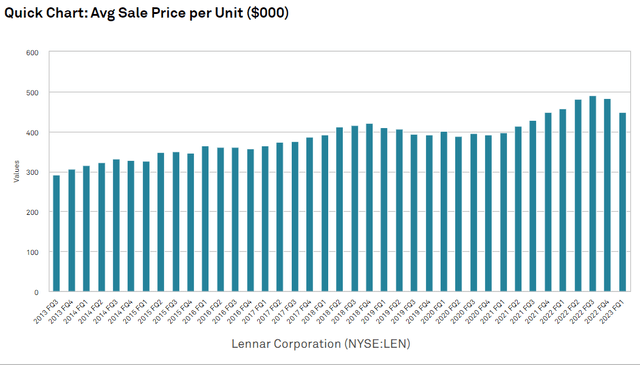
The strategy took a bite out of margins, knocking gross margin down to just over 21%.
S&P Global Market Intelligence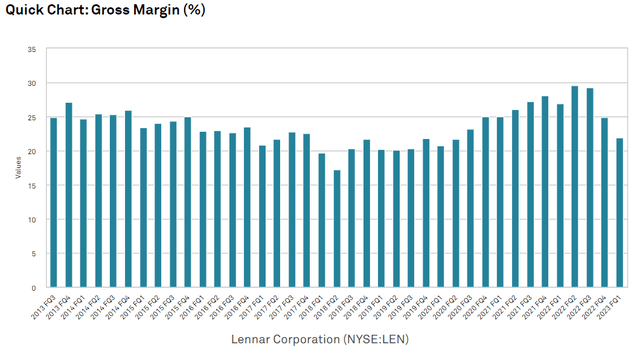
However, I see 3 key benefits to the strategy.
- Increased market share
- Maintenance of supply chain channels
- Ability to reprice higher and restore margin as soon as the environment permits.
LEN's number of homes sold hit record levels in 1Q23. That is a rare statistic amidst a cyclical downturn. First quarter is typically the lightest seasonally, but note that 1Q23 home sales came in higher than any previous 1Q.
S&P Global Market Intelligence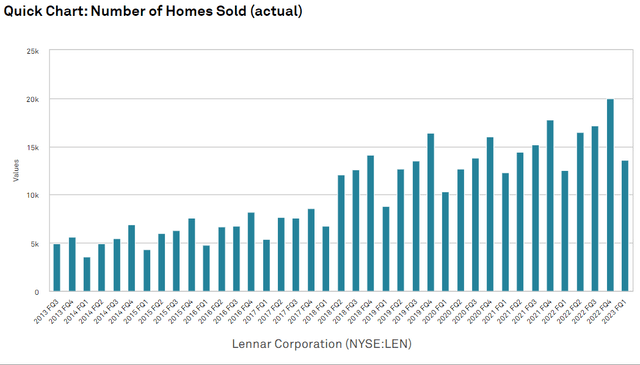
While cutting margins this significantly hurts in the short term, LEN has the balance sheet and liquidity to pull off such a move. If they instead kept prices high and took the hit to volume it causes other problems. Supply chains get shut down which makes it difficult or expensive to ramp back up.
By maintaining its volume LEN maintains its position at the top of the food chain with regard to their supply channels. Operations remain smooth and prices, unlike volume, can be ramped back up instantly. Thus, when the mortgage environment gets a bit friendlier, LEN can instantly raise prices and return to full earnings power.
Valuation
Multiples within homebuilders have consolidated.
S&P Global Market Intelligence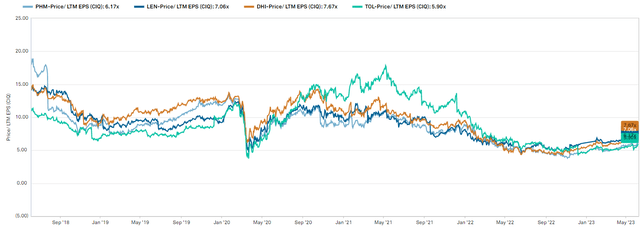
Given the shortage in housing inventory and the tremendous demand for homes over the next 10 years, I think the whole industry can perform well.
LEN and D.R. Horton (DHI) are trading at a slight premium to peers which I believe is warranted due to track record and larger size. Given this premium I am largely indifferent between the main homebuilders as I think the whole sector will outperform the broader market by a similar magnitude.
Advantaged position with LEN.B
That said, there is still an advantaged play in the form of an arbitrage between LEN and LEN.B.
Portfolio Income Solutions Arbitrage Tracker
Despite having equal claim to assets and cashflows as well as enhanced voting power, Lennar's class B shares trade 11.15% cheaper than the class A.
Over time, this gap should close, which suggests that LEN.B has an additional 12.55% upside as compared to LEN.
Risks to ownership
While I believe interest rate risks are overemphasized by the market, there are a few other risks which are worth watching.
- Lumber prices will not remain low forever. Europe will run out of beetle impacted inventory which will cut off imports from Europe and take pricing back up. Additionally, mills in British Columbia are expected to start to shut down as it is a high cost of production region and many are presently operating at a loss. The homebuilders will get to enjoy maybe a year or 2 of really cheap lumber input costs, but the margin gains are fleeting.
- Recession can significantly reduce demand. It remains unknown as to whether the U.S. will have a recession with economists quite split on the forecast. While recession does not permanently reduce demand for homes, it can certainly delay it.
- Speculative risk from 3D printing. Although Lennar is one of the pioneers of 3D printed homes, the technology has the potential to dramatically reduce the cost of homebuilding which eventually reduces the prices they can charge. At this point in time, 3D printing is an irrelevant fraction of the market, but if it becomes a more accepted form of homes it could solve the housing shortage with less overall revenue. Such an event could be a good thing for families affected by the affordable housing crisis, but it would be a new competing supply in the form of substitution.
Opportunistic Market Sale: 20% off for a limited time!
Right now there are abnormally great investment opportunities. With the market crash, some fundamentally strong stocks have gotten outrageously cheap and I want to show you how to take advantage and slingshot out of the dip.
To encourage readers to get in at this time of enhanced opportunity we are offering a limited time 20% discount to Portfolio Income Solutions. Our portfolio is freshly updated and chock full of babies that were thrown out with the market bathwater.
Grab your free trial today while these stocks are still cheap!
This article was written by
2nd Market Capital Advisory specializes in the analysis and trading of real estate securities. Through a selective process and consideration of market dynamics, we aim to construct portfolios for rising streams of dividend income and capital appreciation.
Our Portfolio Income Solutions Marketplace service provides stock picks, extensive analysis and data sheets to help enhance the returns of do-it-yourself investors.
Investment Advisory Services
We now offer a variety of ways to invest with us. Our focus is on maximizing client returns while staying within risk their risk parameters. To learn more about our advisory services you may schedule a 15 minute intro meeting here: https://calendly.com/2mc/intro
Dane Bowler, along with fellow SA contributors Simon Bowler and Ross Bowler, is an investment advisory representative of 2nd Market Capital Advisory Corporation (2MCAC). As a state registered investment advisor, 2MCAC is a fiduciary to our advisory clients.
Full Disclosure. All content is published and provided as an information source for investors capable of making their own investment decisions. None of the information offered should be construed to be advice or a recommendation that any particular security, portfolio of securities, transaction, or investment strategy is suitable for any specific person. The information offered is impersonal and not tailored to the investment needs of the specific person. Please see our SA Disclosure Statement for our Full Disclaimer.
Analyst’s Disclosure: I/we have a beneficial long position in the shares of LEN.B either through stock ownership, options, or other derivatives. I wrote this article myself, and it expresses my own opinions. I am not receiving compensation for it (other than from Seeking Alpha). I have no business relationship with any company whose stock is mentioned in this article.
All articles are published and provided as an information source for investors capable of making their own investment decisions. None of the information offered should be construed to be advice or a recommendation that any particular security, portfolio of securities, transaction, or investment strategy is suitable for any specific person. The information offered is impersonal and not tailored to the investment needs of any specific person. Readers should verify all claims and do their own due diligence before investing in any securities, including those mentioned in the article. NEVER make an investment decision based solely on the information provided in our articles. It should not be assumed that any of the securities transactions or holdings discussed were profitable or will prove to be profitable. Past Performance does not guarantee future results. Investing in publicly held securities is speculative and involves risk, including the possible loss of principal. Historical returns should not be used as the primary basis for investment decisions. Commentary may contain forward looking statements which are by definition uncertain. Actual results may differ materially from our forecasts or estimations, and 2MC and its affiliates cannot be held liable for the use of and reliance upon the opinions, estimates, forecasts, and findings in this article. 2MC does not provide tax advice. The material contained herein is for informational purposes only and is not intended to replace the advice of a qualified tax advisor. S&P Global Market Intelligence LLC. Contains copyrighted material distributed under license from S&P 2nd Market Capital Advisory Corporation (2MCAC) is a Wisconsin registered investment advisor. Dane Bowler is an investment advisor representative of 2nd Market Capital Advisory Corporation.
Seeking Alpha's Disclosure: Past performance is no guarantee of future results. No recommendation or advice is being given as to whether any investment is suitable for a particular investor. Any views or opinions expressed above may not reflect those of Seeking Alpha as a whole. Seeking Alpha is not a licensed securities dealer, broker or US investment adviser or investment bank. Our analysts are third party authors that include both professional investors and individual investors who may not be licensed or certified by any institute or regulatory body.

